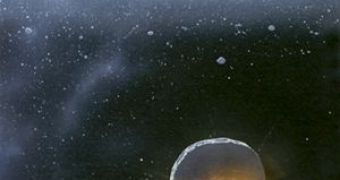Can you imagine an ice ball as big as Pennsylvania hitting an Alaska-sized dwarf planet, spitting off material on the Sun system and delivering two brand new moons for the planet?
This is what happened in the outskirts of our Sun system a few billion years ago. "It's just a spectacular story," said planetary scientist Michael Brown of the California Institute of Technology in Pasadena.
His team found the fragments of the cosmic collision which could explain many unknown issues about the early moments of our solar system. These objects are located in a region named the Kuiper belt, outside Neptune's orbit.
Brown's team discovered the largest Kuiper belt objects, like the dwarf planet Eris, which with its 2400 km diameter is slightly bigger than Pluto, and another one, named 2003 EL61, which is about 70 % of the Pluto's size, with a rugby ball shape due to its extremely fast rotation of less than 4 hours.
This object is as dense as basalt, lacking a low-density icy mantle. This reveals a space collision in the dwarf's past, breaking up 2003 EL61's mantle, set it fast spin, and gave birth to its two small moons.
Brown's team found evidence for this: five smaller Kuiper belt objects located in other areas with similar orbits to that of 2003 EL61. Spectroscopic measurements found that the five bodies (the largest possessing a 400 km diameter) have the surface formed by nearly pure water ice crystals, just like 2003 EL61. "Since the paper was accepted for publication two more fragments have been found. The total number is probably up in the hundreds or even thousands," said Brown.
The discovery is "very unexpected," says theoretical dynamicist Harold Levison of the Southwest Research Institute in Boulder, Colorado. Even at the beginning, when Kuiper belt contained more bodies, very few were large. "The probability of such a collision taking place is almost zero. Because Kuiper belt objects are the leftovers of the formation of the giant planets, the new find will certainly have implications for theories about the early evolution of the solar system," said Levison. "The colliding objects may originally have orbited in the so-called scattered disk--a large, distant population of ice dwarfs whose orbits were strongly perturbed by Neptune's gravity", he believes. "The bright pure-ice surface of 2003 EL61 and its siblings is also a mystery," said Brown.
Due to the orbital spread of the pieces, the collision must have occurred billions of years ago. But icy surfaces are known to become dark and ruddy in less than 100 million years under the effect of cosmic weathering (cosmic radiation and micrometeoroid impacts).
This was not detected in 2003 EL61 or in the smaller fragments. "This shows we don't understand space weathering at all," said Brown.

 14 DAY TRIAL //
14 DAY TRIAL //